Assignment 4: Delft Bicycling Facilities: Lynda Nitka
Facility: Bike Lanes
Location 4: Buitenhofdreef, Martinus Nijhoflaan
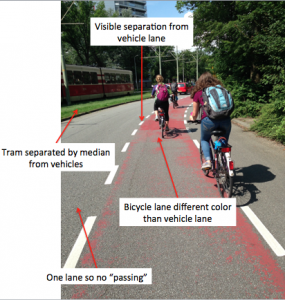
This facility provides safety and convenience because of the fact that the tram, vehicles, and bicycles are all separated in some way. The tram is separated from the vehicles with physical separation, or a median, while the bicycles and vehicles are separated by visible separation, or pavement markings. Additionally, this facility provides safety due to the fact that vehicles travel in one lane, so that the vehicles are not allowed to pass each other. The design benefits from good planning because the measures taken by the engineers who designed this road used the provided space to still allow separation between the varying modes of transportation. Additionally, each lane for each mode of transportation is a sufficient width for the person who is traveling to travel comfortably. Lastly, there is a shoulder on the right of the bike lane which provides even more comfort. I am unsure of the cost of this facility, but it seems as though the engineer who designed this facility used the space given to him/her to the best of his/her ability, given that the vehicles and bicycles are only visibly separated and not physically separated.
Facility: Cycle Tracks
Location 5: Voorhofdreef
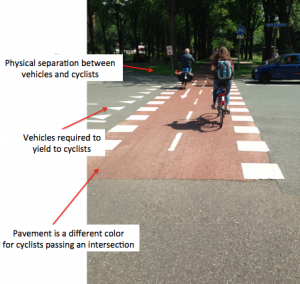
One way that this facility provides safety and convenience is by having the pavement differ in color for cyclists than for vehicles when the cyclist is crossing an intersection. This should provide emphasis to vehicles that they have to yield to cyclists, along with the fact that vehicles have the “shark teeth” pavement markings when crossing an intersection. Additionally, while cyclists are traveling on parts of the roadway that are not part of an intersection, they are physically separated from the roadway by vegetation and trees, providing even further safety. This design benefits from good planning because the cyclists are able to travel in both directions on one side of the street (a two-way bike path), while still being physically separated from motor vehicles. Once again, I am unsure of the cost of this facility, but it seems as though it would be expensive to implement. However, the money used to install this facility was used wisely because of the good amount of space allowed for each mode of transportation.
Location 6: Papsouwselaan
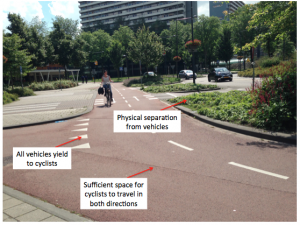
This facility provides safety and convenience because of the fact that pedestrians have the priority, followed by the tram (which includes traffic signals for cyclists, vehicles, and pedestrians), followed then by cyclists, and finally by vehicles. Bicyclists also have a sufficient amount of physically separated travel space, which allows them to exit the roundabout comfortably. This design benefits from good planning because of the safety/convenience measures that I mentioned above, as well as the fact that a roundabout was used as a means of traveling instead of a signalized intersection, since roundabouts provide much less of a delay while traveling through an intersection. This facility was one of the more cost-worthy designs that we visited, but in my opinion it was also one of the most impressive. I have never seen a roundabout that was so comfortable for vehicles, cyclists, pedestrians, and trams to all travel on together.
Location 10: Ruys de Beerenbrouckstraat
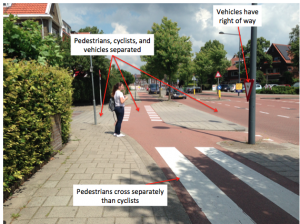
This facility provides an impressive amount of safety and convenience. First of all, cyclists, pedestrians, and vehicles are all visibly or physically separated, so each mode of transportation has their own path of travel without having to worry about other modes of transportation with faster/slower speeds. Additionally, everywhere that a cyclist or pedestrian must cross the motor vehicles’ travel lanes, he or she knows to yield to the vehicles, based on pavement markings and signage. This is one of the only facilities that I measured the widths of the travel lanes for each mode of transportation. Pedestrians had a 7.5 foot travel lane, bicyclists had a 7 foot travel lane, and vehicles had a 10 foot travel lane approximately. Additionally, each of the modes of transportation had at least a 1 foot separation from each other, and bicycles and vehicles were separated by an even wider physical separation. In my opinion, the engineer designed this facility very well based on the fact that there are also houses on either side of the roadway, so he/she probably had to worry about not designing the roadway on private property. Even though the facility was probably expensive to implement, it was definitely one of the more impressive facilities safety-wise.
Facility: Bike Boulevard
Location 7: Buitenwatersloot
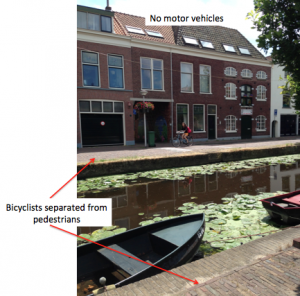
One of the biggest differences that I noticed between this facility and the others was the fact that vehicles were not allowed on this facility, and pedestrians and bicyclists were completely separated by the canal. This is very convenient for vehicles and pedestrians, since there is little worry about injury and/or death, since bicyclists and pedestrians both travel at low speeds, which also means that the facility was designed well. I do not believe that this type of facility would be expensive, being that there are no vehicle travel lanes, so the only space that is needed for travel is the pedestrians’ and bicyclists’ space, which does not amount to much.
Facility: Advisory Lanes
Location 8: Hugo de Grootstraat
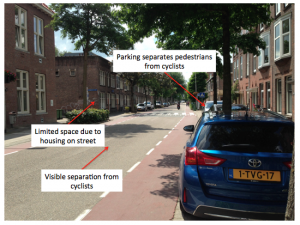
This facility provides as much safety and convenience that is physically allowed on this roadway, being that it is a residential area with housing on both sids of the street. Additionally, it is safe and convenient for pedestrians since pedestrians are physically separated from the vehicles and cyclists by parked cars. Also, the pavement of the cyclists’ travel way differs from the vehicles’ travel way in color. I believe that with the limited amount of space of this facility, the engineer designed this facility well by giving the pedestrians the only physical separation, since pedestrians are most likely to be injured in an accident. I think that this facility was one of the more inexpensive facilities, due to the little amount of space provided to the engineer to design travel ways for vehicles, cyclists, and pedestrians.
Location 9: Adriaan Pauwstraat, Westplantsoen
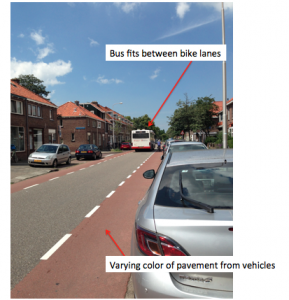
This facility was probably the facility that I felt the least safe on, based on the fact that there was a high amount of traffic and no physical separation between the vehicles and the bicyclists. Additionally, the cycle lanes seemed a bit thinner than the other facilities. I did appreciate the difference in color between the cycle pavement and the vehicle pavement. This design seemed to be designed well, based on the fact that once again the road was lined with houses on either side of the roadway. It did not seem very convenient for pedestrians, since cars seemed to be parking on the pedestrians’ path. Additionally, this facility seemed like one of the more inexpensive facilities, since the bikes were not physically separated from the roadway.
Facility: Service Road
Location 13: Zuipoldersingel
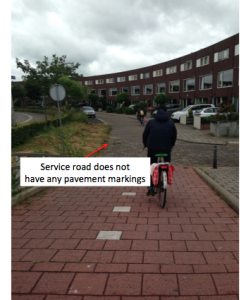
Although this facility did not have any pavements markings, I still felt safe traveling on this roadway since there were no motor vehicles on this roadway. Vehicular traffic was very low, and the one or two cars that I did see traveling on this roadway were traveling at low speeds. I believe that these roadways were designed well, based on the fact that they are only really being used to access the houses on these street. The facility seems to be relatively inexpensive, since there is no separation at all provided between the varying modes of transportation.
Facility: Bike Highway
Location 14: N470 Bike Highway
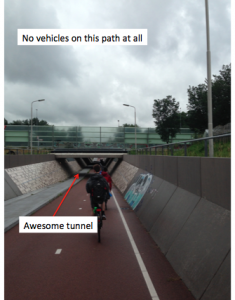
This facility was definitely the one that I felt the most safe on, since the bicycle had the right of way the entire time. Both bike lanes were a sufficient width for traveling, and I felt like I barely had to pay attention to other traffic. It was designed extremely well, especially being that the bicycle lane was next to a major vehicle highway and I still felt safe on the path. I would imagine that the facility would be a bit expensive, since the stretch of roadway was so long, but I think that it was the most well designed.

Leave A Comment